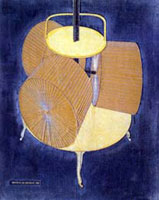click to enlarge
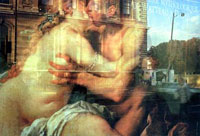
Figure 1
The projection of
a painting on the
glass window
The use of glass in architecture was associated with the use of other artificial materials, such as steel and reinforced concrete. These materials heralded new trends in architecture. Glass was initially incorporated into steel structures destined for railway 0terminals and glasshouses; Paxton and Burton come to mind. Pavilions for national exhibitions(1) like Paxton’s Crystal Palace were also beneficiaries of this new architectural technology. Possibilities for the use of glass were dazzling and transcended the mere technical. (Fig. 1)
Use of glass and the subsequent effect on the space that it enclosed challenged traditional architectural concepts. The most significant change was brought about by the introduction of levity–or the transgression of solidity. Traditionally the stone wall had dictated how architecture was approached and, curiously perhaps, an absence of material introduced the idea of gravity into architecture. A wall brings with it the concept of subtraction for it must be pierced or opened up in some way to allow the entry of light. The oculus of the Pantheon or Salon de Comares in the Alhambra palace are here brought to mind. Glass, for its part, demarcates and encloses. Levity is an intrinsic and unencumbered quality of this material and for whatever reason glass qualitatively increases the density of a space.
Glass came to symbolize anthropological expectations(2) which architects interpreted as a way of stigmatizing incipient modernity(3) . This material triggered a series of reflections regarding its capacity to limit and expand interior space. As far as spatial projection is concerned, use of glass alone is limited as it, in time come to present boundaries and thresholds. It supposes both lines moving towards others, and the disappearance of edges.
The departure of the window as marker, and loss of the objectifying effect of the perforation which can serve to locate a building in its surroundings broadened architectural horizons and brought about new notions of material: not only can visual continuity can be obtained via the glass surface, but also an infernal conflict between the order of the crystal mesh and the flatness of the membrane. This conflict engenders intense conceptual density. The apparent external order or finality implicit in transparent thinness is not so. What we are experiencing here is, in fact, the ideal expression of entropy.(4)
This being so the fascination exerted on man by this material poses a fundamental question: The very natural nature of the architecture that we have been loyal to since the 400s has been architecture linked to seeing, and to the process by which we see. The development of vertical panes of glass between horizontal ones from floor to ceiling meant an opacity of almost zero. The resulting virtually complete transparency of the wall introduced a kind of ontologous motive to the process of construction(5) . This process of association had a direct effect on the construction process and, more importantly it defined a specific way of knowing: Knowing through seeing(6).
This tuning ofperception that enabled glass to be exploited brought about a changein the way one perceived ones surroundings from within buildings as there was now a multiplication of viewing points. The objective perspective was removed. The simplest way of seeing glass incorporated architecture was as a structure that incorporates a personal understanding of the space that can be successively transformed across a horizon defined by a person’s ability to see things(7) . Glass edges, in spatial architectural terms, signify a geometrical space that encloses perpetual multiplicity. The glass space becomes a spatial interpretation of one’s own.
This idea is backed up by the idea of the reversibility of glass through transparency and reflection. A plural reality or truth evolves, which implies the superposition of converging layers; a constant disintegration of the limits and a permanent propulsion of space. Reality and truth stop being the same implying that some kind of totality might be attained. Sight becomes linked to the transformation of consciousness. When one’s view is sequestered by glass, a glass that reveals the visible surroundings moment the moment is expanded. A lasting but fugitive unassailability is conceived: the superposition of time, the detainment and advance of sight ends up becoming an almost aesthetic dimension of the glass itself. Amongst the architectural resonances there is a kind of identification between mind and material(8).
Space, when imagined in this way, is something that is alive. It is a place of continualbirth, of endless possibilities and differences, a fertile generator of signs, rhythms and forms. It is not by mere chance that glass has come to provoke so many questions, it is due to its expressive nature and ability to resonate for man.
Duchamp and the circularity of vision
click to enlarge
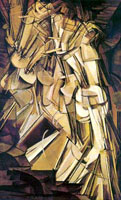
Figure 2
Marcel Duchamp,
Nude Descending a Staircase,
no. 2, 1912
The effort required to envisage space as the superposition of independent layers, each one interacting with one another lies in the identification of the invisiblemarker that runs through all the layers. When Marcel Duchamp painted Nude Descending a Staircase (9) (Fig. 2), of fictitious moments; a series of rhythms that will constitute a defiance of understanding of this situation as any kind of spatial continuity, since what this static collection of captured movements does is dissolve a central idea of an ephemeral moment. It does not capture a precipitation of pure time, but time itself.
This painting, in its spatial development, incorporates time and movement as a definitive element for understanding the object. Its approach is not at all technical; it is dispossessed of expressive techniques like those of Chocolate Grinder number 2 (1914) (Fig. 3) in which disproportionate attention is given to precision and exactitude. Jumping from one work to another is fundamental when trying to understand Duchampian conceptual origins: The Large Glass(10) (Fig. 4) implied a movement from expressive retinal vision to intellectual vision, aimed at understanding. In this work Duchamp made no attempt to represent reality. He was trying to give some kind of presence to reality. This desire to stop the Large Glass being subjected to any kind of aesthetic provoked the appearance of the Green Box (11) in 1934 (11) in 1934 (Fig. 5),, a series of writings, calculations and reflections to be consulted while observing the Large Glass. It would prevent the chance of any kind of association between traditional painting and this work. The need for plastic support to facilitate these readings implicated glass as being a replacement for the traditional canvas, lacking any interpretative possibilities–visual ones aside. In pictorial terms glass signified absence. The transparency of glass makes it a means of a certain type of expression related to its surroundings(12). As the work develops the relationship between the work and the object is established, and vice versa. These links are sustained by the superposition of the significant elements. Having abandoned the spatial development of cubism, whereby fragmentation and development of the object make it plastic, Duchamp extracts that space from the canvas and generates an object capable of holding that space. In this way he establishes a dialogue between ideas suspended in his new glass membrane and those of the observer who approaches, goes round and situates himself in a space shared with the work. The work is nourished by this process of spatial recognition. In preliminary studies for the Large Glass, 9 Malic Moulds (Fig. 6),and the Glider containing a Water Mill made of Neighbouring metals(13)(Fig.7) and Duchamp discovered the possibilities of glass by photographing little sketches drawn on the glass in different spaces and positioning himself for these photographs either in front of or behind the glass. Now it was not a question of seeing less, rather seeing through or, in the case of the encrypted Large Glass, not seeing through the transparency. This fundamental idea of concentrating on the threshold, on the surface of the relation between two faces was concurrent with propositions by the so-called Modern Movement in architecture. Using a thin threshold the dual possibilities of space are suggested. Duchamp is even more challenging as he places the individual inside the space and somehow negates its existence through the affirmative presence the observer, as well as giving the space a relational potency that is activated one the individual is installed.
click images to enlarge
- Figure 3
- Figure 4
- Figure 5
Marcel Duchamp, Chocolate Grinder
number 2, 1914- Marcel Duchamp, The Bride Stripped Bare by Her Bachelors, Even [The Large Glass], 1915-23
- Marcel Duchamp, The Bride Stripped Bare by Her Bachelors Eeven [a.k.a. The Green Box], 1934
click images to enlarge
- Figure 6
- Figure 7
-
Marcel Duchamp, Nine Malic
Moulds, 1914-15 -
Marcel Duchamp, Glider Containing
a Water Mill made of Neighboring
Metals, 1913-15
click to enlarge
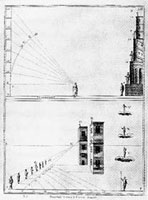
Figure 8
16the
century perspectives by Durer
Thus one possibilityis superposed upon another, a mass of accumulated space projected onto a minimum transparency: A huge amount of meaning is thus conferred upon an evanescent threshold. Here the idea of the infrathin (14) is highly significant, which Duchamp accorded the highest emotional significance. The notion of infrathin is one of focus, focus viewing spatial positions, a definitive nexus with later architectural concepts the qualities of the space to maximum involvement: a crystallized skin that simultaneously resolves the interior space and the exterior symmetries of the building. The projection of different, meaningful layers on one level means that the Large Glass presents a critically suspended perspective. Duchamp’s work as a librarian in St. Genevieve in Paris would allow him to study different treatments of perspective, about which he would make copious notes. Explicit links between the Large Glass and 16th century perspectives would be established at this time, like those of Durer (Fig. 8) who would expose Duchamp to new pathways in the spatial development of the collection as a whole(15). The possibility of changing the traditional concept of spatial representation lead him to conceive of the space as a spatial projection within the space itself, that is to say, not indifferent to it as in a painting, but dependant on it. Having been divested of any kind of gravitational support, objects become linked to a kind of idealized space. The marker nevertheless, and its clearly demarcated lines of division functions with the indescribable power of a decontextualized window (ie estranged from its wall). This marker, however, has the ability to emphasize the idea of transit, of thresholds and of significant space.
click to enlarge

Figure 9
Photo of the Large Glass
taken in Katherine Dreier’s
home at West Redding, Connecticut, summer 1936
Glass turns space towards the observer by suspending retinal values and the subsequent aesthetic enjoyment brought about by contemplating them, it distances the object and affirms the space, which results in the individual questioning the very act of seeing(16). Multiple readings, as well as the projection onto the work of different visions of the surroundings, variations in light, fragmented reflections ultimately expand the process of cognition. (Fig.9) The development of the viewpoint passes from birth asa vision to maturity as knowledge. The individual sees himself looking.In this way, the encounter with the glass leads the observer back to his starting point, in which finally the work confronts the observer with himself, with his space and with his desire to know it. The circularity of the process is ensured.
Notes
 1. The possibilities of expanding the use of glass to other types of buildings were very small, at least in the beginning in the UK. This was before the tax on the consumption of the material was stopped in 1845. The Palm House, by Richard Turner and Decimus Birton (1845 – 1848) was one of the first buildings to benefit from the availability of laminated window panes.
1. The possibilities of expanding the use of glass to other types of buildings were very small, at least in the beginning in the UK. This was before the tax on the consumption of the material was stopped in 1845. The Palm House, by Richard Turner and Decimus Birton (1845 – 1848) was one of the first buildings to benefit from the availability of laminated window panes.
 2. In his novel “Six Memos for the Next Millenium”, Italo Calvino speaks of the Nexus between desired levitation and deprivation suffered as an anthropological constant in which the constant search for levity and expressions of levity were a reaction against the weight of living. (Italo Calvino, Seis Propuestas para el Proximo Milenio. Libros del Tiempo (Madrid: Editorial Siruela, 1989) 39).
2. In his novel “Six Memos for the Next Millenium”, Italo Calvino speaks of the Nexus between desired levitation and deprivation suffered as an anthropological constant in which the constant search for levity and expressions of levity were a reaction against the weight of living. (Italo Calvino, Seis Propuestas para el Proximo Milenio. Libros del Tiempo (Madrid: Editorial Siruela, 1989) 39).
 3. I used glass. Glass alone, without our help, might have destroyed classical architecture. Nowadays glass panes hold perfect visibility,thin sheets of air crystallized to hold air inside and outside Glass is unquestionably modern.
3. I used glass. Glass alone, without our help, might have destroyed classical architecture. Nowadays glass panes hold perfect visibility,thin sheets of air crystallized to hold air inside and outside Glass is unquestionably modern.
( Frank Lloyd Wright, Modern Architecture, being the Kahn lectures. Collected writings, vol 2 (New York: Rizzoli Publications, 1992) 38-39).
 4. “…within the crystal there are constant combinations where the mass of the crystal is shifted to form new structures. The energy that the crystal uses to produce new structures implies that its old structures are broken down… in the natural sciences, this process is called entropy. In other words, the crystal is constantly moving because of breakdowns and structural developments, but outwardly it is maintained by a superordinate system.”
4. “…within the crystal there are constant combinations where the mass of the crystal is shifted to form new structures. The energy that the crystal uses to produce new structures implies that its old structures are broken down… in the natural sciences, this process is called entropy. In other words, the crystal is constantly moving because of breakdowns and structural developments, but outwardly it is maintained by a superordinate system.”
( Robert Smithson, A sedimentation of the mind: Earth Projects. Retrospective works 1955-1973 (Oslo: The National Museum Of Contemporary Art, 1999) 85).
 5.”Invisible but blocking all sound, glass consecrates visibility, thus inviting an experience of objective truth.”
5.”Invisible but blocking all sound, glass consecrates visibility, thus inviting an experience of objective truth.”
( Dan Graham, My Position (Villeurbanne: Nouveau Musée/Presses du Réel, 1992) 15).
 6. “The eye as an organ for seeing things is part of the whole soul’s activity; an organ for looking yes, but the underlying purpose, the ultimate objective, is to see whet cannot be looked at. Looking must become contemplation which must become vision which is knowledge. Vision is a state of consciousness, an extreme atate of attentiveness, like listening, seeing what one knows deep down. Pablo Palazuelo. 1995.
6. “The eye as an organ for seeing things is part of the whole soul’s activity; an organ for looking yes, but the underlying purpose, the ultimate objective, is to see whet cannot be looked at. Looking must become contemplation which must become vision which is knowledge. Vision is a state of consciousness, an extreme atate of attentiveness, like listening, seeing what one knows deep down. Pablo Palazuelo. 1995.
(Translated from Spanish. Pablo Palazuelo, La Vision y el tiemo (Madrid: Museo Nacional Reina Sofia, 1995) 17 – 19)34
 7. …Happily because it is already a house, image of firmness and hollowness that separates it from the earth. In it, in the hut or the shop, first dwelling built by man, the boundary forms the horizon that encircles, demarcates and shelters, it is the personal horizon of its inhabitant…1977
7. …Happily because it is already a house, image of firmness and hollowness that separates it from the earth. In it, in the hut or the shop, first dwelling built by man, the boundary forms the horizon that encircles, demarcates and shelters, it is the personal horizon of its inhabitant…1977
(María Zambrano, Claros del bosque (Barcelona: Ed Seix Barral, 1993) 63-64).
 8.“Intelligent energy with material energy. The deepest srtratum of the mind is “nature”, nature which contains material and the unknown.
8.“Intelligent energy with material energy. The deepest srtratum of the mind is “nature”, nature which contains material and the unknown.
(Geometry and Vision: a conversation with Kevin Power (Canada: Diputacion Provincial de Granada, 1995) p 35).
 9. Nude Descending a Staircase. No. 2, January 1912.
9. Nude Descending a Staircase. No. 2, January 1912.
 10. The Bride Stripped Bare by Her Bachelors, Even [The Large Glass], 1915-23, New York.
10. The Bride Stripped Bare by Her Bachelors, Even [The Large Glass], 1915-23, New York.
“Employer “retard” au lieu de tableau ou peinture; tableau sur berre devient retard en verre–mais retard en verre ne veut pas dire tableau sur verre.–
C’est simplement un moyen d’arriver à ne plus considérer que la chose en question est un tableau–en faire un reatrd dans tout le général possible, pas tant dans les différents sens dans lesquels retard peut être pris, mais plutôt dans leur réunion indécise. “Retard”–un retard en verre, comme on dirait un poème en prose ou eun crachoir en argent.” [Use “delay” instead of “picture” or/”painting”; “picture on glass” becomes “delay in glass”–but “delay in glass” does not mean “picture on glass”–
It’s merely a way of succeeding in no longer thinking that the thing in question is a picture–to make a “delay” of it in the most general way possible, not so much in the different meanings in which “delay” can be taken, but rather in their indecisive reunion. “Dealy”–a “delay in glass” as you would say a “poem in prose” or a spittoon in silver.”
( Duchamp du Signe (Paris: Ed. Flammarion, 1975/1994) 41).
 11.The Bride Stripped Bare by Her Bachlors, Even [The Green Box], 1934, Paris.
11.The Bride Stripped Bare by Her Bachlors, Even [The Green Box], 1934, Paris.
“I wanted that album to go with the “Glass,” and to be consulted when seeing the “Glass” because, as I see it, it must not be “looked at” in the aesthetic sense of the word. One must consult the book, and see the two together. The conjunction of the two things entirely removes the retinal aspect that I don’t like. It was very logical.”
(Pierre Cabanne, Dialogus with Marcel Duchamp, Ron Padgett, trans. (London: A Da Capo, 1979) 42.)
 12. “I don’t know. These things are often technical. As a ground, the glass interested me a lot, because of its transparency. That was already a lot. Then, color, which, when put on glass, is visible from the other side, and loses its chance to oxidize if you enclose it…”
12. “I don’t know. These things are often technical. As a ground, the glass interested me a lot, because of its transparency. That was already a lot. Then, color, which, when put on glass, is visible from the other side, and loses its chance to oxidize if you enclose it…”
(Pierre Cabanne, Dialogus with Marcel Duchamp, Ron Padgett, trans. (London: A Da Capo, 1979) 38.)
 13. Nine Malic moulds. 1914 – 1915 (Paris)
13. Nine Malic moulds. 1914 – 1915 (Paris)
click to enlarge
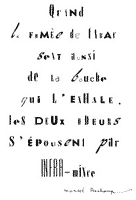
Figure 10
Marcel Duchamp, Note
on the inframince

Figure 11
Photograph of the
surface of water
 14.In Duchamp’s revisions for the Tokyo exhibition of 1980 new unedited notes and manuscripts appeared, in which the word inframince appeared, (Fig. 10) a word that doesn’t exist in French making one of the many plays on words in conceptual art. It is composed of the word infra (low) and mince (thin). The absolute connection between language and plastic expression throws light on this point, finding, amongst other quotes “…painting on glass, seen from this side without painting, creates the infrathin. The Interchange between what is put in view and the glacial observation of the public (that sees and immediately forgets). At least this exchange holds the value of an infrathin separation.”
14.In Duchamp’s revisions for the Tokyo exhibition of 1980 new unedited notes and manuscripts appeared, in which the word inframince appeared, (Fig. 10) a word that doesn’t exist in French making one of the many plays on words in conceptual art. It is composed of the word infra (low) and mince (thin). The absolute connection between language and plastic expression throws light on this point, finding, amongst other quotes “…painting on glass, seen from this side without painting, creates the infrathin. The Interchange between what is put in view and the glacial observation of the public (that sees and immediately forgets). At least this exchange holds the value of an infrathin separation.”
Yoshiaki Tono, responsible for organizing this exhibition, illustrates this term with different photographs of the surface of water, continual, dual and with no thickness (Fig. 11)
 15. References to the different approaches to perspective from this library are important, especially in Durero’s Painting Manual, 1538 and Du Breuil’spractical painting perspective, 1642. Furthermore there existed a significant similarity between sketches that show two superimposed planes of the latter approach and the final perspectival disposition of the Large Glass. Amongst the omotted notes from the Green Box the following stands out (published in A L’infinitif, 1964 “Use transparent glass and mirror for perspective [….] paint the definitive picture “sur glace sans tain (two way mirror thick)…Marcel Duchamp.1913.
15. References to the different approaches to perspective from this library are important, especially in Durero’s Painting Manual, 1538 and Du Breuil’spractical painting perspective, 1642. Furthermore there existed a significant similarity between sketches that show two superimposed planes of the latter approach and the final perspectival disposition of the Large Glass. Amongst the omotted notes from the Green Box the following stands out (published in A L’infinitif, 1964 “Use transparent glass and mirror for perspective [….] paint the definitive picture “sur glace sans tain (two way mirror thick)…Marcel Duchamp.1913.
(Dawn Ades, Neil Cox, David Hopkins, eds., Marcel Duchamp (London: Thames and Hudson, 1999) 111 – 112).
 16. “….ng of that most certainly incomplete vision that his brief look will procure. Contemplative in the stricter sense of leeting himself prolong his regard”
16. “….ng of that most certainly incomplete vision that his brief look will procure. Contemplative in the stricter sense of leeting himself prolong his regard”
(Zambrano, De la Aurora (Madrid: Ed Turner, 1986) 39-40).
Fig. 2-7, 10
©2003 Succession Marcel Duchamp, ARS, N.Y./ADAGP, Paris. All rights reserved.




